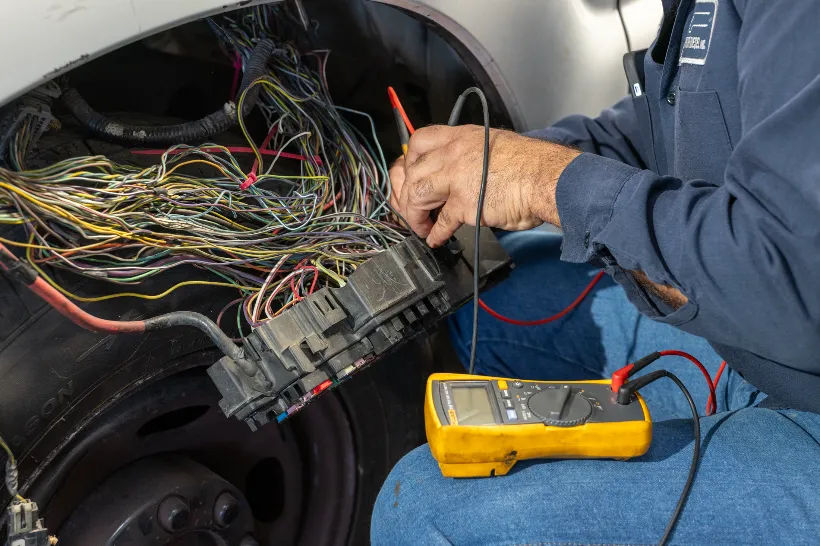.webp)
When it comes to heavy-duty trucks, your braking system is your last line of defense. Whether you're barreling down a Texas highway or grinding through oilfield terrain, you need stopping power that won’t let you down.
However, brake failure in commercial trucks is more common than most realize. And when it happens, this is the fastest way to a dangerous situation on the road. Here, we’ll go through the main causes of brake failure in trucks and, more importantly, how to keep your rig safe and roadworthy.
Common Causes of Brake Failure in Trucks
1. Air System Leaks
Unlike passenger vehicles that use hydraulic systems, most heavy-duty trucks rely on compressed air brakes. If there's a leak in your air lines, compressor, or tanks, the pressure drops and your stopping power vanishes. No air? No brakes.
Prevention Tip: Regularly inspect all air system components, especially air lines and fittings. Listen for hissing sounds and monitor your air pressure gauges closely. Install quality air dryers to prevent moisture buildup and freezing in the winter.
2. Worn Brake Shoes or Linings
This one’s a no-brainer. If your brake shoes are worn down, they won't generate enough friction to stop your truck. The deeper issue is that worn shoes increase stopping distance, strain other components, and generate excessive heat.
Prevention Tip: Add brake inspections to your preventive maintenance schedule. Don’t wait for squealing or weak brakes; measure lining thickness regularly and replace them before they hit minimum specs.
3. Faulty Slack Adjusters
Slack adjusters are designed to compensate for wear in the brake drum system. But what if they’re out of adjustment or seized up? Your pushrod won’t activate the brakes effectively.
Prevention Tip: Inspect and test your slack adjusters during every PM check. Ensure they’re greased, moving freely, and within adjustment range. Don’t rely on auto-adjusters without verifying their function.
4. Contaminated Brake Linings
Oil, grease, or even brake fluid can contaminate brake linings, rendering them useless. Contaminants reduce friction, and that spells trouble when you need to slow down fast.
Prevention Tip: Address leaky wheel seals, axle tubes, or transmission seals as soon as they're spotted. Clean and degrease affected areas thoroughly, and always replace contaminated linings.
5. Overheated Brakes (Brake Fade)
If your truck's barreling down a steep hill and you're riding the brakes, you're risking thermal fade. That’s when your brake drums and shoes get so hot, they stop generating friction. This means your brakes check out when you need them most.
Prevention Tip: Use engine braking systems like Jake brakes or exhaust brakes to reduce heat on long descents. Downshift and avoid excessive use of the brake pedal when hauling heavy loads.
6. Moisture in the Air System
Moisture inside your air system doesn’t just freeze up lines in cold weather. It also corrodes components from the inside out, leading to malfunctioning valves, sticking parts, and, eventually, complete failure.
Prevention Tip: Drain your air tanks daily and check that your air dryer is functioning properly. Replace the dryer cartridge annually or as needed, especially in humid or freezing conditions.
7. Broken or Weak Return Springs
Return springs pull your brake shoes back into place when you release the pedal. If they’re broken or weak, the shoes may drag against the brake drum, causing excessive heat and wear.
Prevention Tip: Check spring tension and replace damaged or stretched springs. Inspect during any drum brake service or rebuild.
8. Improper Brake Adjustment
An improperly adjusted brake won’t apply the correct amount of force. Too tight? You’ll get heat buildup. Too loose? Your stopping distance goes through the roof.
Prevention Tip: Make brake adjustments part of your regular maintenance checklist, especially on trucks with manual slack adjusters. Always follow DOT guidelines for maximum stroke length.
How to Prevent Truck Brake Failures
We’ve gone through the usual suspects. Now let’s talk strategy. Prevention is your ticket to safety, uptime, and keeping DOT inspectors off your back.
Build a Preventive Maintenance Schedule
Texas roads are tough on trucks. Don’t wait until you’re stuck on the side of I-35. Set up a maintenance calendar that includes:
- Brake system inspections
- Air pressure checks
- S-cam and drum inspections
- Compressor and air dryer evaluations
Train Drivers to Spot Issues Early
Your drivers are the first line of defense. If they’re not trained to spot signs of brake fade, low air pressure, or unusual smells, you're flying blind.
Stay Ahead of DOT Inspections
Many out-of-service orders during roadside inspections are brake-related. Avoid the downtime and fines by inspecting:
- Pushrod stroke
- Brake lining thickness
- Air leaks
- Brake responsiveness
Don’t Let Your Brakes Be the Weak Link
By sticking to a solid maintenance plan and keeping an eye (and ear) on your system, you can prevent most of the common culprits before they put you—or someone else—at risk.
Need a brake inspection or unsure if your air system is up to par? Schedule a professional truck brake service with our team at Integrity Fleet Services and make sure your truck’s ready to stop when it counts. Your safety—and your rig’s lifespan—depends on it.
More Articles
.webp)
.webp)
5 Common Tire Maintenance Mistakes That Can Lead to Blowouts
5 Common Tire Maintenance Mistakes That Can Lead to Blowouts
Tire blowouts aren't random—they're preventable. From missed pressure checks to using the wrong tire type, small slip-ups lead to big problems. Learn the 5 most common tire maintenance mistakes that could leave your rig stranded across Rapid City or I-90.


How to Check for Parasitic Draws Draining Your Battery
How to Check for Parasitic Draws Draining Your Battery
A dead battery after downtime? You might be dealing with a parasitic draw—hidden power drains that silently kill your charge. Learn the signs, tools, and step-by-step fixes to track them down, prevent future issues, and keep your fleet running strong and start-ready.


Why Efficient Fleet Management Is Critical for Food and Grocery Deliveries
Why Efficient Fleet Management Is Critical for Food and Grocery Deliveries
Food delivery fleets face no margin for error. In Texas, heat and distance push systems to their limits. From cold chain logistics to cost-saving fuel tactics, this guide explores how efficient fleet management keeps perishables fresh, drivers happy, and profits intact.
